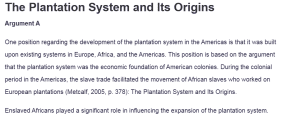The Plantation System and Its Origins
Argument A
One position regarding the development of the plantation system in the Americas is that it was built upon existing systems in Europe, Africa, and the Americas. This position is based on the argument that the plantation system was the economic foundation of American colonies. During the colonial period in the Americas, the slave trade facilitated the movement of African slaves who worked on European plantations (Metcalf, 2005, p. 378): The Plantation System and Its Origins.
Enslaved Africans played a significant role in influencing the expansion of the plantation system. Having noted that enslaved Africans offered effective labor in plantations, European farmers sought to expand even more (Jones, 2025). In particular, African labor was crucial to the success of sugarcane plantations in the Caribbean, where production increased significantly following the involvement of African labor.
On the other hand, European influence in plantations is visible in the methods and purpose of the farming activities. One of the European influences in the way farming activities were carried out in plantations was the focus on cash crops over subsistence farming. Europeans had earlier learned cash crop agricultural insights from Muslim agriculture during the crusades that occurred between the 11th and 13th Centuries (Brown University, n.d.). Specifically, sugarcane farming appealed to Europeans because, before their encounters with Muslim farmers, they only knew about honey as the only sweetener.
Besides, the fact that they could use sugarcane to make alcoholic beverages encouraged them to embrace cash crop farming. Therefore, it is clear that the plantation system in the Americas was influenced by Europeans following their encounters with Muslim farmers. The Americans provided tropical lands where plantations were established after it emerged that West and Central Africa regions were militarily protected for Europeans to occupy these regions.
Argument B
The second argument that explains the emergence of the plantation system is that it foreshadowed the development of modern forms of the economy. One of the goals of the modern economy is profit maximization, and it is seen as one of the factors that influenced the emergence of the plantation system (Brown University, n.d.). Farmers leveraged the existing low production costs to farm produce, which had higher returns. Commercializing agriculture is one of the modern motivations for undertaking agricultural activities.
Also, plantation systems point to another form of modern economic motivation for undertaking farming: wealth accumulation. Whereas farmers previously mostly farmed to fulfill subsistence needs, they started farming to accumulate wealth. In particular, farmers used enslaved people as the liquid capital that helped the elites generate wealth. Such wealth was transferred to subsequent generations as inheritance.
Another feature in the modern economy that may be characterized by plantation farming is risk management. The major participants in the plantation systems sought to leverage the available slave labor to act as a buffer against economic fluctuations (Jones, 2025). Major participants in plantation farming considered slaves as a natural resource that could be leveraged when other mechanical technologies to be used in farms were not available. For instance, the usage of the steam engine that later replaced human labor in most farms was occasionally replaced with African slaves.
Also, plantation owners sought to address market shortages that had been experienced earlier due to environmental circumstances. For instance, following the Haitian revolution, Saint Dominique collapsed, leading to significant sugar shortages. To that end, plantation farmers sought the financial benefit that would result from selling sugar. Therefore, modern market dynamics played a significant role in influencing plantation farming.
References
Brown University. (n.d.). Feitorias and Engenhos: The Changing Economy of Colonial Brazil | Brazil: Five Centuries of Change. Library.brown.edu. https://library.brown.edu/create/fivecenturiesofchange/chapters/chapter-1/feitorias-and-engenhos/
Jones, N. (2025). Africans in America/Part 1/Norrece Jones on the early status of Africans in Virginia. Pbs.org. https://www.pbs.org/wgbh/aia/part1/1i2993.html
Metcalf, A. C. (2005). The Entradas of Bahia of the Sixteenth Century. The Americas, 61(3), 373–400. https://doi.org/10.1353/tam.2005.0036
ORDER A PLAGIARISM-FREE PAPER HERE
We’ll write everything from scratch
Question
For your first assignment, you will need to read the five documents in this week’s module and be prepared to cite them in your answer. You can use any citation style that you feel comfortable with, but please include page numbers when citing the article by Metcalf (the PDF version includes page numbers).
I want you to use this week’s reading to explain TWO opposing arguments. To clarify, I am not asking for your opinion, I am asking you to explain both positions using evidence from this week’s readings. You do not need to cite every reading, but you must cite the article by Metcalf and at least two other sources.
Argument A: The plantation system of the Americas was built upon existing systems in Europe, Africa, and/or the Americas.
Argument B: The plantation system was a new invention that foreshadowed more modern forms of economy.

The Plantation System and Its Origins
You can address the two arguments separately or in a single essay. Either way, your answers must be written in formal paragraphs.
ONLY USE PROVIDED LINKS AND FILE in order to complete this assignment. NO AI tool is allowed.
LINKS:
- https://ldhi.library.cofc.edu/
exhibits/show/african_ laborers_for_a_new_emp/ slavery_in_iberia_before_the_t - https://www.theguardian.com/
cities/2016/mar/21/story-of- cities-6-potosi-bolivia-peru- inca-first-city-capitalism - https://library.brown.edu/
create/fivecenturiesofchange/ chapters/chapter-1/feitorias- and-engenhos/ - https://www.pbs.org/wgbh/aia/
part1/1i2993.html

